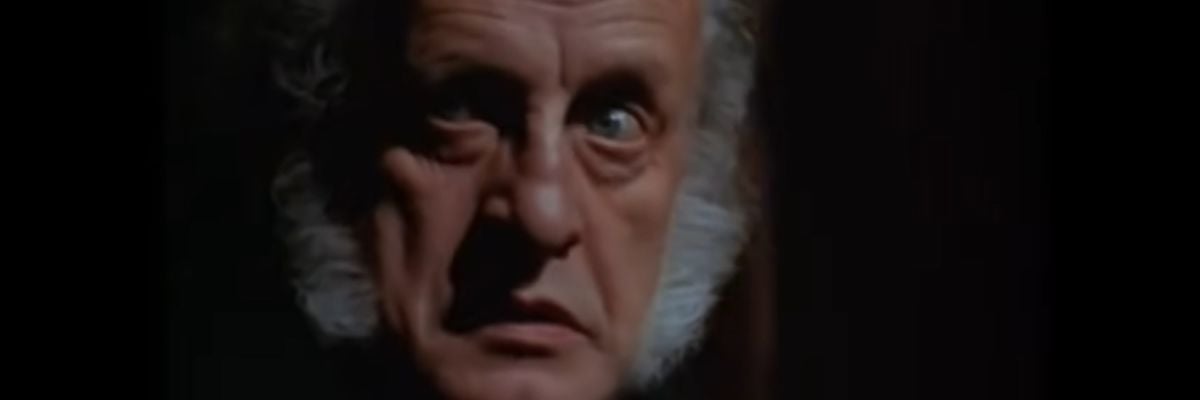
Charles Dickens’s 1843 classic, “A Christmas Carol,” has been the object of countless adaptations, on the stage, in cartoons, and movies. Unfortunately for many Americans, it’s become a children’s Christmas ghost story, though that is neither what Dickens intended nor how we should read it.
My favorite movie version of the “Carol” is Clive Donner’s 1984 film, starring George C. Scott. Louis Bayard is right in observing that here, we get “an Ebenezer Scrooge with hands, organs, dimension, senses, affections. A Scrooge who when you prick him, bleeds.”
Scott’s Scrooge is a real man, a man immersed and quite content in his sins, arrogantly certain of the rightness of his opinions. His clerk is a cheat for wanting “a day’s wages for no work,” his nephew a fool for marrying a “poor girl.” Little can he imagine the conversion being offered him as he walks home Christmas Eve.
Scrooge is visited by four spirits: Marley and the Ghosts of Christmas. Though religion per se is not explicitly mentioned in the film (or the original “Carol”), it is present. Scrooge’s conversion, his “reclamation,” is the work of the spirits. That’s a Catholic truth: conversion is a supernatural work of grace.
Although Scott’s spirits are presented as supernatural, they are not ethereal, not remote, not “ghostly.” One element of realism always struck me: when Marley appears and prepares to speak, he unwinds the bandage around his head, causing his slack jaw to drop noisily. In pre-embalming England, a corpse’s head was normally bound to keep the mouth shut.
In his encounter with the Ghost of Christmas Past, Scrooge asks whether she represents Noel “long past,” only to be told, “No, your past.” She is there not out of some theoretical exercise, but for a personal end: “your welfare.” And when Scrooge complains about the light emanating from her head, asking her to cover it with the overgrown candle snuffer she bears, she answers, “I bring the light of truth. Would you use this cap to put it out?” The answer is yes, as we see in the final scene with her, as Scrooge wrestles her to the ground, forcing the cap over her. He screams, “I’ve had enough of your pictures from the past! Haunt me no longer!” while she intones, “Truth lives! Truth lives!”
A Polish priest once defined a saint as “somebody who is unafraid of his biography.” We see from his encounter that Scrooge neither wants to see his past nor consider the choices that have led him to his present. Yet those are the first steps of conversion.
The “Ghost of Christmas Present” manfully invites Scrooge to “come and know me better!” He walks him through the Christmas streets of London, where Scrooge only sees “a lot of buying,” but the Ghost promises to show him “to what good use these wares can be put.” And though the Spirit showcases the joys of Christmas, he does not deny its shadow side, the side of Christmas where there is no room at the inn: the homeless family, the children Ignorance and Want that gnaw at the Spirit, and the dying Tiny Tim.
The “Ghost of Christmas Future” has always been—to me—the Masterpiece of Dickens’s “Carol.” One must be an excellent storyteller to weave memento mori into a Christmas tale. That is what the Spirit of Christmas Yet to Come does. He shows Scrooge how “men’s courses may foreshadow certain ends” and where Ebenezer’s are leading. But this film brings out clearly—in ways other films do not—that it is not Scrooge’s death, but how he is dead that is the catalyst for his conversion. It may not be a supernatural “loss of heaven and pain of hell,” but it is at least an inchoate awareness of what John Paul II made clear in Redemptor Hominis: a man “remains a being . . . incomprehensible for himself, his life is senseless, if love is not revealed to him, if he does not experience it and make it his own” (10), especially to the degree that he is responsible for that lack.
Scott’s Scrooge is also, in his own way, politically correct, and his Spirit visitors generally seem to enjoy swatting that correctness. When Marley tries to reason with him to accept his presence, he encounters all manner of Scrooge’s equivocations about sensory knowledge and “more of gravy than of grave to you” until he rattles his chains and scares the pants off Ebenezer. When Scrooge assures the Ghost of Christmas Past how he met social expectations (and forfeited Belle) by achieving “financial success,” she readjusts his vision: “You have explained what you have gained; now I will show you what you have lost.” And when Scrooge repeats the nineteenth century’s version of Planned Parenthood’s advice to the poor—die and “decrease the surplus population”—the Ghost of Christmas Present puts Scrooge in his place “so that in the future you might hold your tongue until you discovered what the surplus population is and where it is. It may be in the sight of heaven that you are worthless and less fit to live than millions like this man’s child.”
This film is extraordinarily faithful to Dickens’s original text. Yet a careful consideration of its content brings out the richness and complexity of the call to conversion everyman faces, bound by the influences of his situated unfreedom and yet called to be more: to be the glory of God fully alive.
Enjoy this film this Christmas! “And God bless us, everyone!”
Image credit: A Christmas Carol (1984) via mreesm, YouTube, CC BY 3.0.



